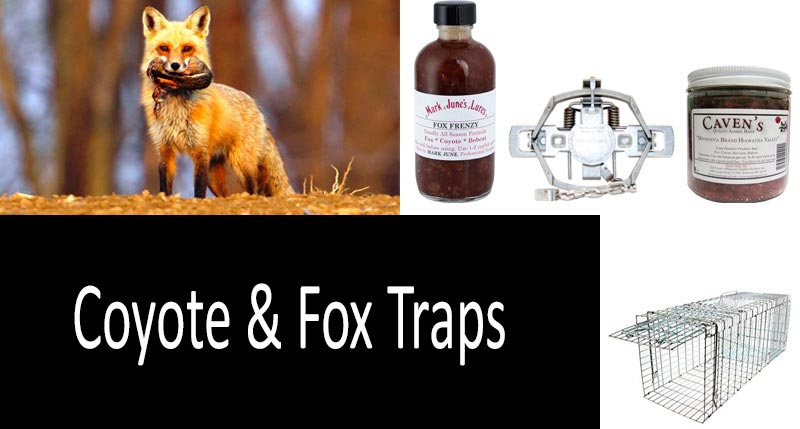This article was reviewed April 2022, and due to Amazon’s new policies for trap sales some of the trap links are unavailable. However, we are working on making these items available to you from a different vendor. Until then, we hope you still enjoy this article and all the information it has to offer. Thank you.
With the expansion of human settlements into wildlife areas, owners of the lands adjacent to these areas are faced with an increased occurrence of conflicts between humans and the most common predators living in the vicinity of people — coyotes and foxes. Chicken, sheep, lambs, and other livestock are regularly killed by these predators, resulting in considerable damage to producers. Crop fields and gardens are also endangered in regions where coyotes and foxes are active. On the other hand, they have learned to take advantage of urban environments where food, water, and shelter can be found in abundance. Foraging in garbage cans or consuming rodents, coyotes and foxes have got accustomed to living side by side with people and cannot be easily driven out from suburbs and towns.
This is one of the main reasons why fox and coyote traps is the most effective way to solve this problem. Just imagine a predator hungry for meat! It will not be an easy task to repel it by means of the foul smell or scare out using loud devices. An immediate effect is likely to follow but the predator will return in a while as its survival instinct is affected. And that is where traps of various types come handy! This solution ensures the result and helps you eliminate the predator either by removing it with the help of a live trap or killing with a fox and coyote trapping. In this article, you will learn what scientists say about how to catch a coyote or fox, as well as what fox and coyote trapping baits can be applied. We have prepared a comparison table of coyote and fox traps, as well as a review of the most popular products available on market.
Table of Contents:
- Understanding The Behavior Of Foxes And Coyotes
- How To Trap A Fox
- How To Trap Coyotes
- Fox & Coyote Traps: Comparison Table
- TOP 6 Fox & Coyote Traps and Baits
Understanding Animal Behavior Essential for Successful Fox and Coyote Trapping
The first thing you should realize is that coyotes and foxes do their best to avoid humans because they scent potential danger we pose to them. This is facilitated by the fact that both these predators are normally active in the dark. Therefore, encounters with humans are rare, although they do occur, for example, in cases when a person is walking the pet or engaged in the outdoor activities like camping and hiking. But this fact does not make it any easier since coyotes and foxes do not need the presence of humans to destroy our livestock, poultry, and crops on a farm, as well as kill pets and rodents in a town. Once a predator has tried this easy prey, it will hardly give up. So, be ready for a heavy fighting and arm yourself with powerful weapons.
What are we dealing with? Сoyotes look like medium-sized domestic dogs, with a weight not exceeding fifty pounds. They have a slender body with long legs and straight, pointed ears. Typically, coyotes are gray in color with the white underside. Their tracks are also difficult to distinguish from those of dogs, however, there is a peculiarity you can take into account — coyotes leave more oblong and narrow tracks which are approximately 3 inches long and 2 inches wide. Tracks of their front feet are larger.
As for foxes, several their species are widespread in the United States, with the red fox and gray fox being the most problematic ones in terms of causing damage to human property. Foxes belong to the dog family as well but, unlike coyotes, have a bright distinctive feature — their signature bushy tail. The red fox has a white tip at the end of the tail while the gray fox’s tail has a black tip. Both of them are typically 3 feet in length and weigh about 10 pounds. These two species can be easily distinguished by the color of their fur, with that of the red fox being orange and the gray fox being salt-and-pepper in color.
Populations of both coyotes and foxes are steadily growing, so does the amount of the damage they cause. Although coyotes are normally active at dawn and dusk, you have a chance of encountering them in the daytime as well. Scientists from Auburn University Auburn University point out that these animals are territorial and their packs include a male, female, and their pups. Some grown coyotes may remain nomadic without the marked territory, however, when a pack is formed, a territory ranging from 1.5 square miles to 10 square miles is established. Most of the coyotes do not live more than 3 years, and yet some individual coyotes have been found as old as 12 years.
Foxes breed and live in dens which they do not burrow themselves but, instead, occupy the existing ones. When disturbed, they can easily move to another den, or they may have several dens within their territory. That’s probably why foxes have been labeled by people being lazy and cunning. This may also come from their habit of preferring the most accessible food, which is why foxes can be found eating almost anything from poultry to berries, seeds, fruits, and garbage.
How To Trap A Fox
Fox trapping may be a very effective solution, however, you should have enough knowledge to obtain the desired result. Otherwise, you will only teach foxes to avoid such devices and, subsequently, even professionals will have to invent something sophisticated when speculating about how to catch a fox after it has been “trained” so well by an inexperienced trapper.
Traps suitable for foxes are the Nos. 1 1/2, 1 3/4, and 2 double coil spring trap and the Nos. 2 and 3 double long spring trap. Traps with offset and padded jaws cause less injury to confined animals and facilitate the release of non-target captures. Trapping regulations vary depending on the states, so, it is necessary to consult a local wildlife agency to comply with the law in your fox control efforts.
It is crucial to set fox traps in the appropriate place. First of all, look for trails. If you have discovered the route, it is already half the work! Set your trap there and you are likely to have the animal caught soon. Apart from that, an entrance to fields is a good location to set a fox trap since this is where they frequent to eat something delicious. Do not forget about fox baits which should be an important part of your trapping strategy. The most effective fox trapping bait is a carcass as it is a typical food for these predators. There are other kinds of lures which can be both homemade or purchased from the store. To achieve the optimal result, vary and combine scents of fox baits to increase the chances of successfully catching a fox.
According to Mr. Phillips, a dirt-hole trap set is the most effective. Dig a hole which should be six inches in depth and three inches in diameter. Put some fox baits there, for example, several drops of the scent attractive to these animals. Then, move back from this hole and dig another one. The second hole should be two inches in depth which is enough for a trap with chain. Cover the trap with the soil and make sure that the device is set firmly.
Choose a fox trap cage to capture juvenile foxes in an urban environment. The main advantage of this option is that it does not pose any risk to children or pets who may accidentally be harmed by other types of traps. Also, this is a humane method allowing you to remove the predator without killing it. And yet, cages are considered not to be effective against adult red foxes which are experienced enough to avoid them. Neck snares are recommended by scientists as the best fox trap catching all species of foxes. They should be set either in trails or in openings such as holes under fences which are often used by foxes to get into your property. For foxes, make a six-inch loop, the bottom of which should be about ten inches above ground level. Scientists have studied the use of neck snares to live trap foxes. They have concluded that snaring foxes is an effective way to capture them alive. Neck snares take little time to set up, usually cost less than other capturing methods and are effective under most weather conditions.
Apart from setting fox traps properly and in the right place, you should also be aware of some facts about their maintenance. After purchasing the trap, clear the device from the factory oil finish. Nor should you allow it contact with any substance producing a strong smell since this will likely keep foxes away from the trap. In order to clear the device from oil or other substance, boil it in water. Also, it will be helpful to bury it in the moist soil for several days. Finally, keep the trap clean, because the proper maintenance is a necessary condition for any trap to be effective.
How To Trap Coyotes: Rules of Successful Coyote Trapping
When it comes to coyote control, trapping is the most effective way to protect your livestock and crops. Various coyote traps are available, so, let’s have a look at their advantages and disadvantages. Leghold traps are the best way to trap coyotes. The advantage of the device is that you can release the unharmed non-target animal which was caught although was not intended to be. Scientists from the University of Nebraska – Lincoln suggest using coyote foot trap as the most popular and traditional capturing device, however, in some states this type of trap is prohibited.
The public pressure has stimulated manufacturers to improve the leghold trap over the years, and now these devices are available with padded and laminated jaws, center-mounted chains as well as other modifications making them more humane and effective. For example, laminated jaws reduce the number of injury cases among the captured coyotes. Jim Armstrong, a wildlife specialist at the Alabama Cooperative Extension, points out a No. 3 coil spring trap, the strong point of which is its adjustable trigger mechanisms, so that you can prevent other animals including pets from being caught and harmed. Also, unlike long spring traps, coil spring traps can be hidden more easily. Specialists from Texas A&M AgriLife Extension Service consider No .3 or No. 4 double spring leghold traps with offset jaws to be the most effective coyote traps.
When trapping in urban and suburban areas, the devices should be set in places where coyotes have been repeatedly noticed while other animals, on the contrary, are not active. Most importantly, notify residents of the neighborhood about the coyote foot traps you have set, so that no pet or child will be put at risk. Also, activate the trap during hours of darkness — the time that coyotes are roaming in search of food.
The main advantage of cage traps is that it provides a possibility to live trap coyotes, without harming them. However, this device is the least effective since coyotes, as well as foxes, are wary enough and are hard to be lured inside the cage. Therefore, this is not a good option for managing problem coyotes. And yet, if you have decided on a cage trap, choose an item no less than 1.6 meters in length, attach a carcass inside it as a coyote trapping bait. In addition, covering the floor with natural materials will be helpful.
Snares are effective under all weather conditions and simple in use. However, in order to capture an animal, one should be an experienced trapper. Snares can be employed both to kill a predator or capture it alive. A non-lethal method is particularly essential in suburbs and towns so that if a wrong animal is trapped, you can release it. For coyotes, a 12-foot snare with a 1/16-inch diameter is recommended. Such snare will help you avoid catching a deer instead of a coyote.
“Snares can be very useful in situations when problem coyotes’ travel routes are obvious, such as when coyote follow a defined pathway from an undeveloped area into a suburban neighborhood, or pass through or under a fence, into which a snare can be set,” scientists from the University of Nebraska – Lincoln claim.
Where and how should you set a trap? There are four sets recommended by scientists for coyotes: dirt hole sets, scent post sets, trail sets, and carcass sets.
- Find a scent post or pour coyote urine on a plant or any other visible object near the pathway. Set a trap six inches away from it. Being a curious animal, a coyote will show interest in the smell and will approach the scent post to investigate it.
- We have already described a dirt hole set with regard to foxes. This technique can also be used to capture coyotes, but the size of the hole should be larger — up to 5 inches large and about 8 inches deep. Set the trap six inches in front of the hole. Do not forget to place a coyote trapping bait.
- The trail set is helpful in places where coyotes get into your property by crawling under the fence and follow the same routes. Also, it works if coyotes have become too cautious and start to ignore scent posts. Set a trap on the trail placing sticks or any other small objects on each side of the device so that the predator gets directly into a trap. The advantage of this method is that there is no need for baits or odor attractants. A disadvantage lies in the risk of livestock and other animals traveling the same pathway and being caught by accident.
- As coyotes regularly consume fresh carcasses, setting traps near the bodies of dead animals is effective as well. Place the device along trails leading towards the carcass in order to prevent other animals from being captured.
Fox & Coyote Traps: Comparison Table
Effectiveness Scale: 1 being the least, 10 being the most effective.
| Type of Trap | Advantages | Disadvantages | Effectiveness (1-10) |
| Coil Spring Trap | It has adjustable trigger mechanisms preventing non-target animals from being captured. Easy to conceal. Scientists recommend No. 2 double coil spring trap for foxes and No. 3 coil spring traps for coyotes. | Its effectiveness depends on weather conditions. Restricted in some states, so, you should consult local wildlife agency. | 10 |
| Padded Leghold Trap | It has a strip of synthetic nylon between steel jaws making the trap more humane. Leghold traps are considered to be the most effective in capturing coyotes and foxes. | Critics claim that the strip is too thin to make the device humane. Rubber pads could freeze in winter. Its effectiveness depends on weather conditions. Restricted in some states, so, you should consult local wildlife agency. | 9 |
| Offset Leghold Trap | A 3/16-inch gap between the closed jaws leaves space for blood flow to the trapped limb. It is both more humane and effective as the animal may chew the trapped limb if blood flow is blocked. Leghold traps are considered to be the most effective in capturing coyotes and foxes. | Its effectiveness depends on weather conditions. Restricted in some states, so, you should consult local wildlife agency. | 10 |
| Laminated Leghold Trap | Its jaws are wider and their pressure is spread over the captured limb. This results in better blood flow. The trap causes less injury to the captured animals and makes it easier to release non-target animals. Leghold traps are considered to be the most effective in capturing coyotes and foxes. | Its effectiveness depends on weather conditions. Restricted in some states, so, you should consult local wildlife agency. | 9 |
| Cage Trap | A good option to live-capture foxes and coyotes without causing harm to them. Cage traps are effective in capturing young and inexperienced predators. Perfect and safe option for the urban environment to avoid occasional victims. A cage which is at least 1.6 meters in length with a carcass inside is likely to do the job. | Coyotes and foxes are wary animals and often avoid a cage trap; considered to be ineffective for adult animals. Requires lures and baits with the strong smell. | 8 |
| Snares | Effective under all weather conditions. Can be used both as a lethal and non-lethal trap. Useful if you know travel routes of the problem coyote or fox. Snares are cheap and require less time to be set. | Requires experience to capture the target animal and not make it suffer. Non-target animals can get into the trap. It often causes extreme pain or slow strangulation to the animal. If the captured animal manages to escape, the embedded snare wire infects the wound leading to prolonged death. | 6 |
TOP 6 Fox & Coyote Traps And Baits
Below you will find a review of four most popular traps for coyotes and foxes, as well as two products containing baits intended for luring the target animals into your trap. There are two modern modifications of leghold trap — a coil spring trap with rubber padded jaws and that with offset jaws. Both of them are designed to reduce the incidence of injuries to the captured coyotes and foxes. A trap cage is perfect to live trap coyotes and foxes and is recommended for the use in urban settings. 5-foot snares are the cheapest option but require a wealth of experience and are known to cause significant harm to the animals.
Duke 0474 Fox & Coyote Foot Trap, Rubber Padded Jaws
This coil spring trap is designed to capture coyotes. According to scientists, No.3 is the best version for capturing coyotes and the product meets this requirement. As for foxes, No.2 is preferable but this one can be used as well. Its rubber padded jaws are intended to reduce the incidence of injuries to the captured animals, however, some experts claim that padded traps make no difference in case the rubber freezes under low temperatures. And yet, studies show that injuries from rubber padded traps are lower than that of other traps. The product is made of steel and powered by several coil springs.
Minnesota MB-450-Offset Jaw Predator Trap rates 4.4 out of 5 stars, however, there are not enough reviews to evaluate customer experience. “Great trap. You will need to adjust the pan. If used correctly you will have perfect results,” a satisfied buyer said.
MB-550 Fox & Coyote Foot Trap, Offset Jaws
Traps with offset jaws is another and more effective modification of traditional leghold trap, making the device more humane and preventing the animal’s escape. The trick is in a gap between the closed steel jaws which allows for blood flow to the trapped limb. This fact provides two advantages. First, offset jaws make coyote foot trap more humane, secondly, the animal is likely to chew the limb if it is numb and escape. This trap is small enough for the fox and tough enough for the coyote. The outside jaw spread is 5 1/2 inches and the inside one is 4 3/4 inches. There is a 3/16-inch gap between the closed jaws, which is enough for blood flow to the limb.
MB-550 Offset Trap rates 4.6 out of 5 stars, with 91% of the customers giving it five stars. “The 550 is one of the best coyote traps around… It could catch animals from a coyote down to the smaller armadillo,” a buyer claimed. “The only trap that we feel comfortable for trapping the elusive coyote…The 550’s will hold the biggest Eastern Coyotes,” another customer wrote in his review. Some users have stressed that this trap is a great way of protecting their pet dogs from aggressive coyotes.
Coyote & Fox Trap Cage
A cage trap is ideal for those unwilling to harm coyotes and foxes in any way, capture them alive and subsequently release. Smoothed internal edges of this item prevent injuries to the captured animals. Also, this trap is recommended for urban areas, where other kinds of traps may pose a risk to pets and children.
This cage is 50 x 24 x 19 inches in size, which is more than enough both for foxes and coyotes. As we have mentioned above, scientists advise using cages which are 1.6 meters (about 40 inches) long. This one is ten inches longer than that of the recommended size, which is a clear advantage since extra space makes the animal feel more safe and confident. Therefore, it will be easier to lure both these wary predators inside the cage. The trap is made of galvanized wires and has reinforced door and latches. So, feel free to leave it outdoors without worrying that the structure may get rusty. In addition, the product has an anti-glare coating so that it will not look suspicious in the dark.
The product rates 3.1 out of 5 stars. “We caught a coyote. We were shocked because we live in a small town in Florida & had no idea they were around. We set it free,” a customer said. “Perfect size for coyotes. Love it that it folds flat for storage. It’s not that heavy and triggers well,” another buyer noted. However, one of the customers complained that the captured fox had managed to escape from the cage.
Price: Check the current price
Ausable 5-foot Coyote & Fox Snare Trap
This option is the cheapest one but, at the same time, requiring enough experience to set a snare trap properly. The manufacturer recommends the snares for fox and coyote trapping, particularly, by placing in crawling spaces under the fences. The product is 5 feet in length and is made of galvanized 3/32 inches aircraft cable. It has a swivel on end, a proven lock, and a rubber support collar. A crimp-on deer stop is included to prevent deer from being trapped. If there is a deer stop on a snare, a deer can shake its foot out of the trap and escape. One more advantage of this product lies in its weather-resistant properties so that it can be used in sub-zero temperatures without getting frozen. However, each state has its own regulations regarding the use of snares, therefore, you should contact your local wildlife agency for more information before purchasing the item.
Ausable snares rate 3.8 out of 5 stars, with 87% of the customers giving it five stars. “My neighbor down the road said not to use them because of his dog. I said I didn’t think about a dog getting caught so I won’t use them. Gave them to my son which lives in a dog-free area and he has caught 2 coyotes so far. Respect other people’s pets. The snares work like a charm, poor coyotes..” one customer wrote in his review.
Frenzy Fox Trapping Bait, 2.8 oz
The active ingredient of this trapping bait is a blend of fox glands and musks, which will attract not only foxes but coyotes as well throughout the year. One bottle has a volume of 2.88 ounces. Put the bait near a leghold trap or in a cage trap to lure the animals inside. According to the manufacturer, the lure has become one of the largest selling fox attractants in the USA.
The fox trapping bait rates 3.7 out of 5 stars. “Set trap up the first night without using the Fox Frenzy Lure. The next morning found a raccoon waiting for me in the trap. Freed. That evening set the trap up again. This time dipping a Q-Tip in the Fox Frenzy and dropping the Q-Tip at the end of the trap. The next morning, had a fox. With that result, it works!” a satisfied customer wrote.
Meanwhile, some customers claimed that the product repelled foxes instead of attracting them: “Used it with bait in a live fox trap beside chicken coop. A fox smelled it and hasn’t been back in a month after taking 15 chickens and nightly visits”. Well, it is a good result but apparently not something one should expect from a lure.
Price: Check the current price
Pete Rickard’s LA202 Trapping Paste
Pete Rickard’s LA202 Trapping Paste contains a blend of rodent meat, castor, as well as glands of the fox, rat, and mink. The mix is really powerful, given that both foxes and coyotes view rodents as an easy prey and are known to consume them often, especially when living in the urban environment. The smell is so strong that it can be perceived even from a long distance — the fact confirmed by customers. The product is recommended for using in the dirt hole set.
The bait rates 4.2 out of 5 stars, with 83% of the customers giving it five stars. As one of the users put it: “Caught 20 coyotes with it so far. Stinks something awful but the coyotes in my area love it.” Based on consumer feedback, it seems that the smell is really nasty but attracts coyotes and not only them.
Price: Check the current price
Also check the best fox repellents and deterrents here.
TOP 6 Coyote & Fox Traps And Baits: Comparative Chart
| Product | Type | Price |
Minnesota MB-450-Offset Jaw Predator Trap  | Coil spring trap with offset jaws | Check Price |
MB-550 Fox & Coyote Foot Trap  | Coil spring trap with offset jaws | Check Price |
Coyote & Fox Trap Cage  | Cage 50 x 24 x 19 inches in size | Check Price |
Ausable 5-foot Coyote & Fox Snare  | 5-foot snare trap | Check Price |
Frenzy Bait, 2.8 oz  | Fox trapping bait; active ingredients: a blend of fox glands and musks. | Check Price |
Pete Rickard’s LA202 Trapping Paste  | Coyote trapping bait; active ingredients: a blend of rodent meat, castor, as well as glands of the fox, rat, and mink. | Check Price |











1 thought on “Coyote & Fox Traps”
I already lost two hens, and another one was traumatized after a fight with a fox. So it can not continue any more. I can not sit and watch the chicken coop all night. I want to try the most powerful trap, that it would work for sure and leave no chance for the fox to escape. My choice was based on Coyote & Fox Trap Cage. Do you think it’s worth buying? Or take a trap that will harm them?